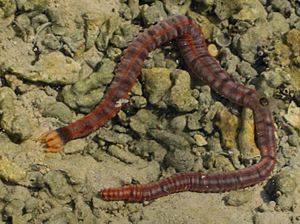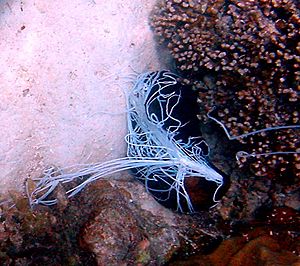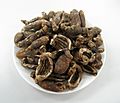Sea cucumber facts for kids
Sea cucumbers are amazing ocean animals, part of a group called echinoderms. Their scientific name is Holothuroidea. They look a bit like long, leathery tubes and live on the floor of the ocean. Most of them are scavengers, meaning they eat tiny bits of food from the sand and mud. There are about 1500 different kinds, or species, of sea cucumbers! They have special ways to breathe and protect themselves from animals that might want to eat them. Some people, especially in China, even eat them as food.
Like all echinoderms, sea cucumbers have a kind of internal skeleton just under their skin. This skeleton is made of tiny, hard pieces, usually joined by soft tissue. Sometimes these pieces can be bigger, forming a kind of armor. However, some sea cucumbers that float in the open ocean don't have this skeleton at all.
Quick facts for kids Sea Cucumber |
|
|---|---|
 |
|
| Scientific classification | |
| Kingdom: | |
| Phylum: | |
| Class: |
Holothuroidea
|
Contents
About Sea Cucumbers

Sea cucumbers can talk to each other by sending special chemical signals, called hormones, through the water.
A really cool thing about these animals is their body wall. It's made of a special material called collagen. They can make this collagen loose or tight whenever they want! If a sea cucumber wants to squeeze into a tiny crack, it can loosen its body and flow into the space. Once inside, it can tighten its body again to stay safe and firm.
These animals have a unique way of breathing. They have an internal "respiratory tree" that floats inside their body. At their rear end, they pump water in and out. This allows them to take in oxygen from the water through their respiratory tree, which is connected to their gut.
How Sea Cucumbers Defend Themselves

Some types of sea cucumbers that live on coral reefs have a surprising way to protect themselves. When they feel scared, they can shoot out sticky threads called cuvierian tubules. These threads are attached to their breathing system inside their body. When startled, they can push these threads out through a small tear near their rear end. This squirts sticky threads all over any animal trying to eat them! Don't worry, new threads grow back in about one to five weeks.
Sometimes, when they release these sticky threads, they also let out a toxic chemical called holothurin. This chemical is a bit like soap and can harm or even kill other animals nearby. This is another amazing way these slow-moving animals can defend themselves.
Other sea cucumbers, which don't have these sticky threads, have an even more dramatic defense! They can actually split their gut wall and push out their insides, including their gut and breathing tree. It sounds gross, but they can grow all these parts back later! Scientists who have seen this happen say it's a very effective way to scare off predators.
These amazing defense methods help explain why sea cucumbers don't need a strong, hard skeleton like some of their ancient relatives.
What Sea Cucumbers Eat
Sea cucumbers have special tube-like feet around their mouth. These are like branched, stretchy tentacles, much bigger than their regular tube feet. Depending on the species, a sea cucumber can have between ten and thirty of these tentacles. They use these sticky tentacles to collect tiny bits of food and small organisms from the ocean floor.
Images for kids
-
"Auricularia" larva (by Ernst Haeckel)
-
Holothurians plate by Ernst Haeckel from his Kunstformen der Natur (1904)
-
Synaptula lamperti lives on sponges (here in Indonesia).
-
Haisom cah jamur, Chinese Indonesian sea cucumber with mushroom.
-
Deep fried sea cucumbers.
-
Kripik teripang, Indonesian sea cucumber cracker.
See also
 In Spanish: Pepinos de mar para niños
In Spanish: Pepinos de mar para niños



































